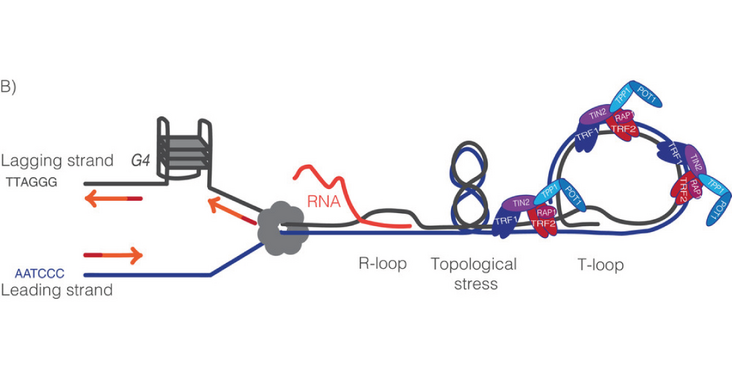Recently, two reviews by the Lingner lab (EPFL) have been published on "Challenging endings: How telomeres prevent fragility" in BioEssays and "The makings of TERRA R-loops at chromosome ends" in Cell Cycle.
Abstract "Challenging endings: How telomeres prevent fragility"
It has become apparent that difficulties to replicate telomeres concern not only the very ends of eukaryotic chromosomes. The challenges already start when the replication fork enters the telomeric repeats. The obstacles encountered consist mainly of noncanonical nucleic acid structures that interfere with replication if not resolved. Replication stress at telomeres promotes the formation of so-called fragile telomeres displaying an abnormal appearance in metaphase chromosomes though their exact molecular nature remains to be elucidated. A substantial number of factors is required to counteract fragility. In this review we promote the hypothesis that telomere fragility is not caused directly by an initial insult during replication but it results as a secondary consequence of DNA repair of damaged replication forks by the homologous DNA recombination machinery. Incomplete DNA synthesis at repair sites or partial chromatin condensation may become apparent as telomere fragility. Fragility and DNA repair during telomere replication emerges as a common phenomenon which exacerbates in multiple disease conditions.
Abstract "The makings of TERRA R-loops at chromosome ends"
Telomeres protect chromosome ends from nucleolytic degradation, uncontrolled recombination by DNA repair enzymes and checkpoint signaling, and they provide mechanisms for their maintenance by semiconservative DNA replication, telomerase and homologous recombination. The telomeric long noncoding RNA TERRA is transcribed from a large number of chromosome ends. TERRA has been implicated in modulating telomeric chromatin structure and checkpoint signaling, and in telomere maintenance by homology directed repair, and telomerase - when telomeres are damaged or very short. Recent work indicates that TERRA association with telomeres involves the formation of DNA:RNA hybrid structures that can be formed post transcription by the RAD51 DNA recombinase, which in turn may trigger homologous recombination between telomeric repeats and telomere elongation. In this review, we describe the mechanisms of TERRA recruitment to telomeres, R-loop formation and its regulation by shelterin proteins. We discuss the consequences of R-loop formation, with regard to telomere maintenance by DNA recombination and how this may impinge on telomere replication while counteracting telomere shortening in normal cells and in ALT cancer cells, which maintain telomeres in the absence of telomerase.
Link to the Article in BioEssays (Open Access)
Link to the Article in Cell Cycle (Open Access)
Abstract "Challenging endings: How telomeres prevent fragility" and figure from Glousker and Lingner (2021) BioEssays published under a CC BY-NC 4.0 license.
Abstract "The makings of TERRA R-loops at chromosome ends" from Valador Fernandes et al. (2021) Cell Cycle published under a CC BY-NC-ND 4.0 license.
